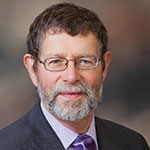Tuesday’s plenary session will be a mix of Society business and personal accounts of delivering emergency care during natural disasters.
The highlight of the session will feature three personal descriptions of delivering emergency medical care and dealing with the public during two of the worst natural disasters in recent U.S. history.
Kalpalatha Guntupalli, MD, and Naseem Alavian, MD, volunteered to remain at Ben Taub Hospital in Houston to deliver care during Hurricane Harvey in August 2017. Harvey was the costliest U.S. hurricane on record, causing $125 billion in damage, largely due to catastrophic flooding in the Houston area. Harvey was also responsible for more than 100 deaths, most in the Houston area.
“I have been through eight or nine hurricanes in the 30 years I have lived in Houston,” Dr. Guntupalli said. “This is the first time we were the target. There was so much water we were handing out life jackets so people could be safer if they had to venture outside.”
John Balmes, MD, volunteered to field media and public medical and health questions during wildfires that swept through Sonoma, Napa, and adjacent counties in Northern California in October 2017. He was also a primary public medical contact during the Thomas fire that blackened nearly 300,000 acres in December near Santa Barbara, California.
Wildfires destroyed more than 10,000 structures in California last year, more than the last nine years combined. The final death toll hit 43, more than the past 10 years combined, according to the state officials. Fires were driven by a deadly combination of high temperatures, low humidity, and sustained winds up to 60 mph that drove embers and flames faster than firefighters could follow.
“People had to literally run for their lives,” Dr. Balmes said. “And they didn’t always make it.”
At the end of the session, current ATS President Marc Moss, MD, will pass the presidency to Polly Parsons, MD. The Plenary will run from 11:45 a.m. to 1:15 p.m. in Hall H.
Dr. Parsons talked about her goals and expectations for the coming year with the Daily Bulletin.
Kalpalatha Guntupalli, MD
Professor of Pulmonary Medicine and Frances K. Friedman & Oscar Friedman, M.D. ’36 Endowed Professorship for Pulmonary Disorders, Baylor College of Medicine, Chief of Pulmonary, Critical Care, and Sleep Medicine, Ben Taub Hospital, Houston
“There were a lot of situations in the hospital, but nothing we couldn’t handle. The worst is just getting to and from work during a natural disaster. It’s not sexy, but we had one staffer coming in to ride out the storm who was trapped in his car by rising waters. He had to break a car window and swim to the building.”
Naseem Alavian, MD
Chief Resident, Ben Taub Hospital, Houston
“When you are providing care during a natural disaster, your team has to absolutely trust your leadership and you have to absolutely trust your team. We all had the same goal: that we would provide the most exceptional care we could in this setting. My team knew I would kill to get them what they needed, and I would expect them to kill to help our patients. It takes complete and total dedication to the task at hand.”
John Balmes, MD
Professor of Medicine, University of California San Francisco Medical School
“In terms of human health, most wildfires are about smoke. Under the right conditions, hot, dry winds, high temperatures, low humidity, these fires move beyond the ability of fire departments to deal. The actual flames took entire communities by surprise and burned them to the ground. With climate change, we are expecting more extreme conditions like we saw last year, more catastrophic wildfires. We have to be better prepared in the future.”



